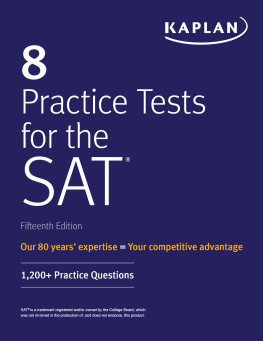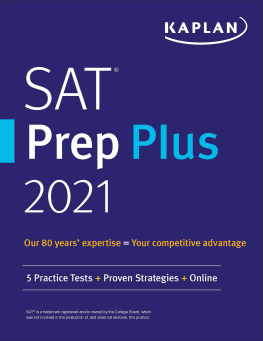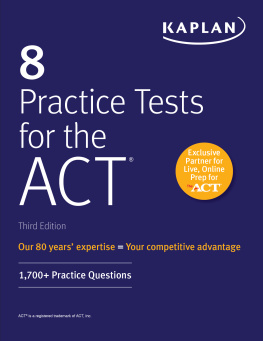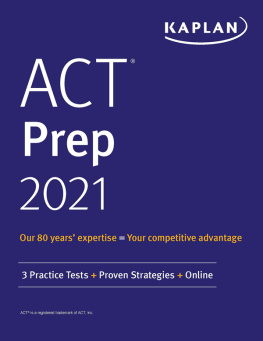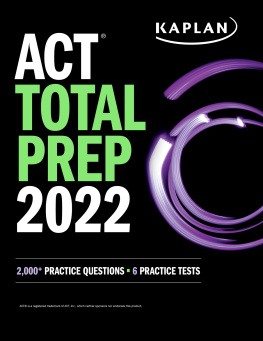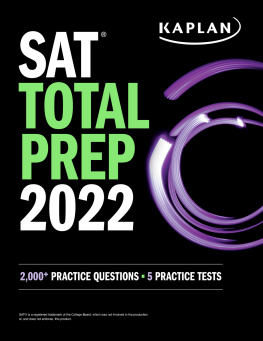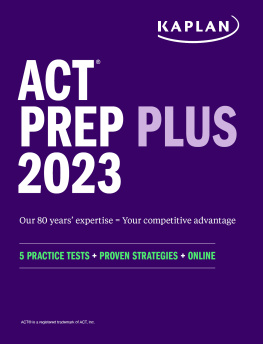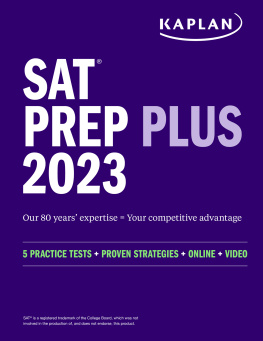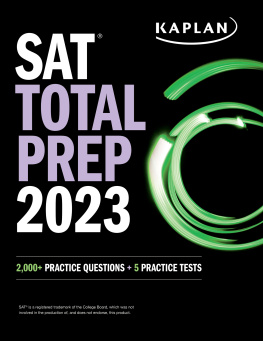
Page iii
TABLE OF CONTENTS
Page iv
Page v
Page vii
Page viii
Page ii
Editor-in-Chief
Alexandra Strelka, MA
Contributing Editors
Dr. Brandon Deason, MD; M. Dominic Eggert; Kathryn Sollenberger, MEd; Glen Stohr, JD
Special thanks to our faculty authors and reviewers
Michael Cook; Christopher Cosci; Boris Dvorkin; John Evans; Jack Hayes; Rebecca Knauer; Jo LAbbate; Bird Marathe; Karen McCulloch; Melissa McLaughlin; Gail Rivers; Anne Marie Salloum; Jason Selzer; Gordon Spector; Caroline Sykes; Bob Verini, MFA; Bonnie Wang; and Ethan Weber
Additional special thanks to
Laura Aitcheson; Matthew Callan; Paula L. Fleming, MA, MBA; Joanna Graham; Adam Grey; Rebekah Hawthorne; Rebecca Knauer; Abnia Loriston, MEd; Mandy Luk; Kristen Murner, PhD and the countless others who made this project possible.
SAT is a trademark registered and/or owned by the College Board, which was not involved in the production of, and does not endorse, this product.
This publication is designed to provide accurate information in regard to the subject matter covered as of its publication date, with the understanding that knowledge and best practice constantly evolve. The publisher is not engaged in rendering medical, legal, accounting, or other professional service. If medical or legal advice or other expert assistance is required, the services of a competent professional should be sought. This publication is not intended for use in clinical practice or the delivery of medical care. To the fullest extent of the law, neither the Publisher nor the Editors assume any liability for any injury and/or damage to persons or property arising out of or related to any use of the material contained in this book.
2019 by Kaplan, Inc.
Published by Kaplan Publishing, a division of Kaplan, Inc.
750 Third Avenue
New York, NY 10017
All rights reserved under International and Pan-American Copyright Conventions. By payment of the required fees, you have been granted the non-exclusive, non-transferable right to access and read the text of this eBook on screen. No part of this text may be reproduced, transmitted, downloaded, decompiled, reverse engineered, or stored in or introduced into any information storage and retrieval system, in any form or by any means, whether electronic or mechanical, now known or hereinafter invented, without the express written permission of the publisher.
ISBN-13: 978-1-5062-3696-4
Page x
How to Use This Book
Congratulations on taking this important step in your college admissions process! By studying with Kaplan, youll maximize your score on the SAT, a major factor in your overall college application.
Our experience shows that the greatest SAT score increases result from active engagement in the preparation process. Kaplan will give you direction, focus your preparation, and teach you the specific skills and effective test-taking strategies you need to know for the SAT. We will help you achieve your top performance on test day, but your effort is crucial. The more you invest in preparing for the SAT, the greater your chances of achieving your target score and getting into your top-choice college.
Are you registered for the SAT? Kaplan cannot register you for the official SAT. If you have not already registered for the upcoming SAT, talk to your high school guidance counselor or visit the College Boards website at www.collegeboard.org to register online and for information on registration deadlines, test sites, accommodations for students with disabilities, and fees.
Practice Tests
Kaplans practice tests are just like the actual SAT. By taking a practice exam you will prepare yourself for the actual test day experience. Two of your practice tests are included in this book and three more can be accessed online. See the Digital Resources section below to learn how to access your online practice tests.
Chapter Organization
The chapters in this book follow a standard format to make this book as easy to use as possible. Most chapters in this book start with a section called How Much Do You Know? that allows you to get a sense of how comfortable you already are with the material in the chapter. Answers and explanations follow immediately in the Check Your Work section. Each lesson in a chapter starts with a question typical of the way the SAT tests a given topic and ends with a set of practice questions called Try on Your Own. There is yet another practice set at the end of each chapter called How Much Have You Learned? to reinforce the concepts explained in the chapter. Answers and Explanations for the Try on Your Own and How Much Have You Learned? sections are provided at the end of each chapter for easy reference.
Smartpoints
Different topics are worth different numbers of points on the SAT because they show up more or less frequently in questions. By studying the information released by the College Board, Kaplan has been able to determine how often certain topics are likely to appear on the SAT, and therefore how many points these topics are worth on test day. If you master a given topic, you can expect to earn the corresponding number of SmartPoints on test day.
We have used a 600-point scale for Smartpoints because thats the number of points you can earn within the Math and Verbal subscores: the SAT scoring scale is 200800, so there are 800 200 = 600 points to be earned within each major section of the test. The breakdown of SmartPoints for Math, Reading, and Writing & Language are summarized in the following tables. Keep in mind that these values are approximate because testing administrations differ.
Page xi
| Math |
| SmartPoints Category | # of Points | Sub-Categories |
| Linear Equations | 110 | Linear equations, linear graphs, word problems |
| Functions | 105 | Functions, graphs of functions, functions in word problems |
| Ratios, Proportions, and Percents | 70 | Setting up a proportion to solve for an unknown, unit conversion, calculating percent and percent change |
| Geometry | 65 | Triangles, circles, 3-dimensional figures |
| Quadratics | 60 | Quadratic equations, parabolas, modeling data, mixed systems of equations |
| Statistics and Probability | 50 | Descriptive statistics, probability, tables and charts, data samples |
| Systems of Linear Equations | 45 | Systems of equations, number of possible solutions |
| Inequalities | 35 | Inequalities, graphical representations of inequalities |
| Scatterplots | 25 | Scatterplots, lines of best fit, modeling data |
| Exponents, Radicals, Polynomials, and Radical Expressions | 25 | Exponents, radicals, polynomial operations, graphs of polynomials, modeling growth and decay, rational expressions/equations |
| Imaginary Numbers | 5 | Adding, subtracting, multiplying, and dividing complex numbers |
| Trigonometry | 5 | Sine, cosine, tangent |
| TOTAL | |
| Reading |
| SmartPoints Category | # of Points | Sub-Categories |
| Inference questions | 90 | Making deductions |
| Command of Evidence questions | 60 | Citing evidence |
| Detail questions | 45 | |
Next page


